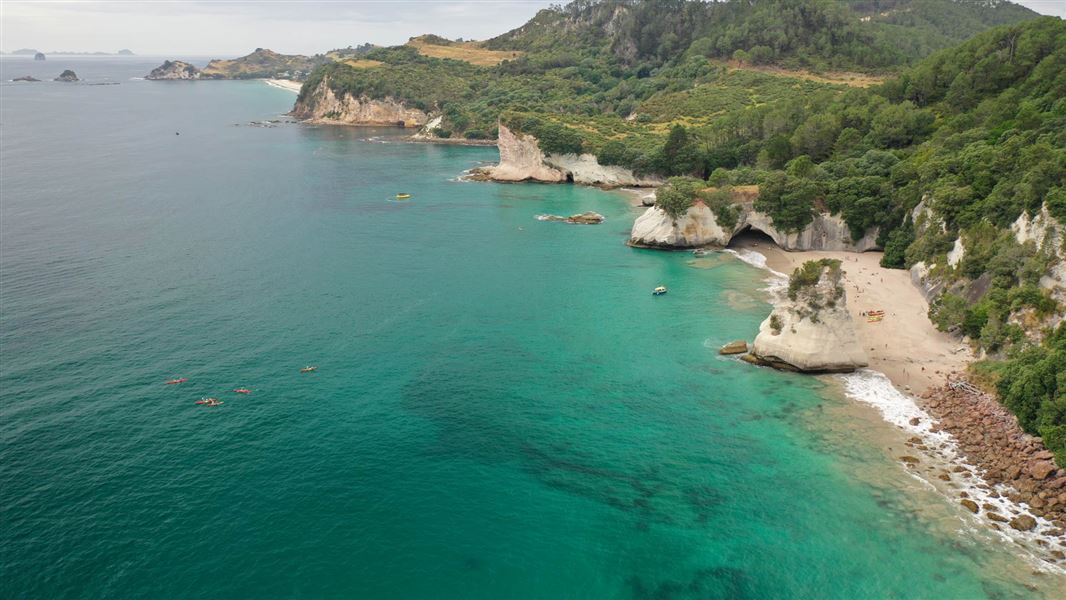This marine reserve will double in size from 25 October 2025 as part of the Hauraki Gulf/Tīkapa Moana Marine Protection Act.
Travelling by car, the trip is about one and a half hours drive from Thames in the west, and about two and a half hours drive from Auckland.
From Thames on the western side of the Coromandel Peninsula, travel east across SH25A which then joins SH25. Travel north on SH25 towards Whitianga and follow the signs to Hahei.
Island access
Access to Poikeke Island and Motueka Island is prohibited without permission from Ngāti Hei.
To help protect marine life inside the reserve, remember:
- no fishing of any kind, either from a boat or from shore
- no taking or disturbing any marine life, including shellfish and seaweeds
- no taking of any part of the sea floor, including rocks and shells
- no feeding the fish as it disturbs their natural behaviour.
Penalties for failure to comply under the Marine Reserves Act 1971 include confiscation of equipment, vessels or vehicles, fines and imprisonment.
Be aware of the boating rules of marine reserves (see the Marine Reserves Regulations 1993):
- The maximum speed permitted for all boats in New Zealand is 5 knots (about 9 km/h) within 200 m of shore or any boat with a dive flag, and within 50 m of any other boat or swimmer.
- Waste, ballast and sewage must not be discharged within the reserve.
- Drop your anchor responsibly to avoid damage to the reserve, and use the minimum amount of chain necessary.
Water safety
If you plan to enjoy the water, learn how to stay safe when swimming, boating and fishing.
It is currently the only marine reserve in the Waikato region and Coromandel Peninsula.
Kina barrens
Kina (urchin) barrens are areas of rocky reef that lack natural kelp cover. Kina graze on kelp and their population increase leads to dramatic losses in kelp cover. Kelp is an important habitat and food source for marine communities, so when kelp forests are lost it affects the diversity and productivity of the whole ecosystem.
These barrens have become an ecological indicator for the overfishing of species that graze on kina, such as snapper and kōura. Scientists have found kina numbers increase when snapper and crayfish populations are reduced. Kina barrens are less common within marine reserves (including Te Whanganui-o-Hei), as the kina’s natural predators such as snapper and kōura have been able to recover.
Reporting pests
Find-A-Pest lets you report potential pest species, including marine, plant, animal and fungal species.
If you come across something out of the ordinary, upload a picture to the app and a specialist will help identify it. If it's a biosecurity threat, this will be forwarded to Biosecurity New Zealand. If possible, take photos and record the location and name of the vessel.
Or call the Ministry for Primary Industries' Pest and Diseases hotline on 0800 80 99 66.
Report illegal or suspicious activity
Don't take, disturb, kill or damage anything within the reserve - it's illegal. If you see people taking anything from the reserve, report the activity as soon as possible.
You can call 0800 4 POACHER (0800 476 224) or 0800 DOCHOT (0800 362 468).
It is also an offence to pollute or litter the reserve, discharge any firearm in or into the reserve or erect any structure in the reserve.
Te Whanganui-o-Hei/Cathedral Cove Marine Reserve is part of the area first claimed by Hei, a tohunga (priest) on Te Arawa waka at the time of the Polynesian migration to New Zealand, circa 1350 AD.
Hei settled his people on the area around Mercury Bay, asserting ownership by referring to Motueka Island as 'Te Kuraetanga-o-taku-Ihu' ('The outward curve of my nose').
It is said he made this claim near the present day site of Hahei. Hei's descendants, as tangata whenua, still retain a strong ancestral and spiritual attachment to the site, and continue their role as guardians, or kaitiaki, of the resources within it.
 No dogs allowed
No dogs allowed
To protect our native wildlife, dogs are not allowed anywhere in this place.
Protect our marine reserves
- No fishing of any kind.
- Don't take or kill marine life.
- Don't remove or disturb any marine life or materials.
- Don't feed fish - it disturbs their natural behaviour.
- Take care when anchoring to avoid damaging the sea floor.
DOC Customer Service Centre
| Phone: | 0800 275 362 |
| Email: | coromandeldistrict@doc.govt.nz |
| Address: | Whitianga Base |
